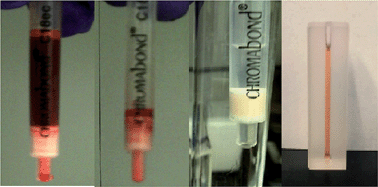Comment on “Rapid visual detection of blood cyanide” by C. Männel-Croisé and F. Zelder, Analytical Methods, 2012, 4, 2632
Abstract
Cyanide poisoning from inhaled HCN is all too common in victims of smoke inhalation in fires. While the toxic effects arise primarily from its inhibitory effects on cytochrome c oxidase, the majority of the cyanide binds to methemoglobin (metHb) in the blood. It can be considered as the detoxification mechanism: one of the antidotes used earlier was nitrite which primarily works by converting hemoglobin to metHb (normally present to the extent of ∼1% of the total hemoglobin). Vitamin B12 (hydroxocobalamin) and related analogs have long been known to have high affinity for cyanide and have been used as antidotes – the binding of cyanide to many compounds in this general family also results in a significant change in color that can be used for analytical purposes. Männel-Croisé and Zelder (Anal. Methods, 2012, 4, 2632) have advocated direct addition of a related compound to blood samples and isolating the colored measurand on a solid phase extraction cartridge. While they demonstrated attractive rapid measurement of cyanide in spiked blood samples, we believe that this is not a practically usable procedure regardless of the exact chromogenic reagent used. Cyanide bound to metHb dissociates too slowly for a 1 min reaction to work as suggested – we believe for reasons unknown (e.g., metHb levels in their blood samples unusually low), cyanide added to their blood samples did not (have time to) bind to metHb and these samples may not resemble real situations where significant amount of the cyanide will be bound to metHb.


 Please wait while we load your content...
Please wait while we load your content...